Abstract
The genetic and clinical features of 46 patients in nine families with "pure" hereditary spastic paraplegia are described. Inheritance was autosomal dominant in seven families and autosomal recessive in two. In dominant kinships, five families corresponded to type I with onset below 35 years, and two to type II with onset over 35 years. In early onset dominant families, in spite of apparent complete penetrance before 20, variable expression and incomplete penetrance occurred. Irrespective of genetic type, serial evaluation revealed that the main symptom consisted of slowly progressive spastic gait, extremely variable in severity, associated in some patients with decreased vibratory sense and micturition disorders generally as late features. In dominant families, the disease tended to be more severe in late onset cases. No patient had symptoms in the upper limbs and plantar responses were flexor in six symptomatic patients. Central motor conduction time studied by transcranial magnetic stimulation was always normal in the upper limbs and increased in the lower limbs in five of the eight patients on whom it was performed. Monomorphic and stereotyped clinical pattern in this series does not support the concept of multisystem involvement of the central nervous system as a hallmark of the disease.
Full text
PDF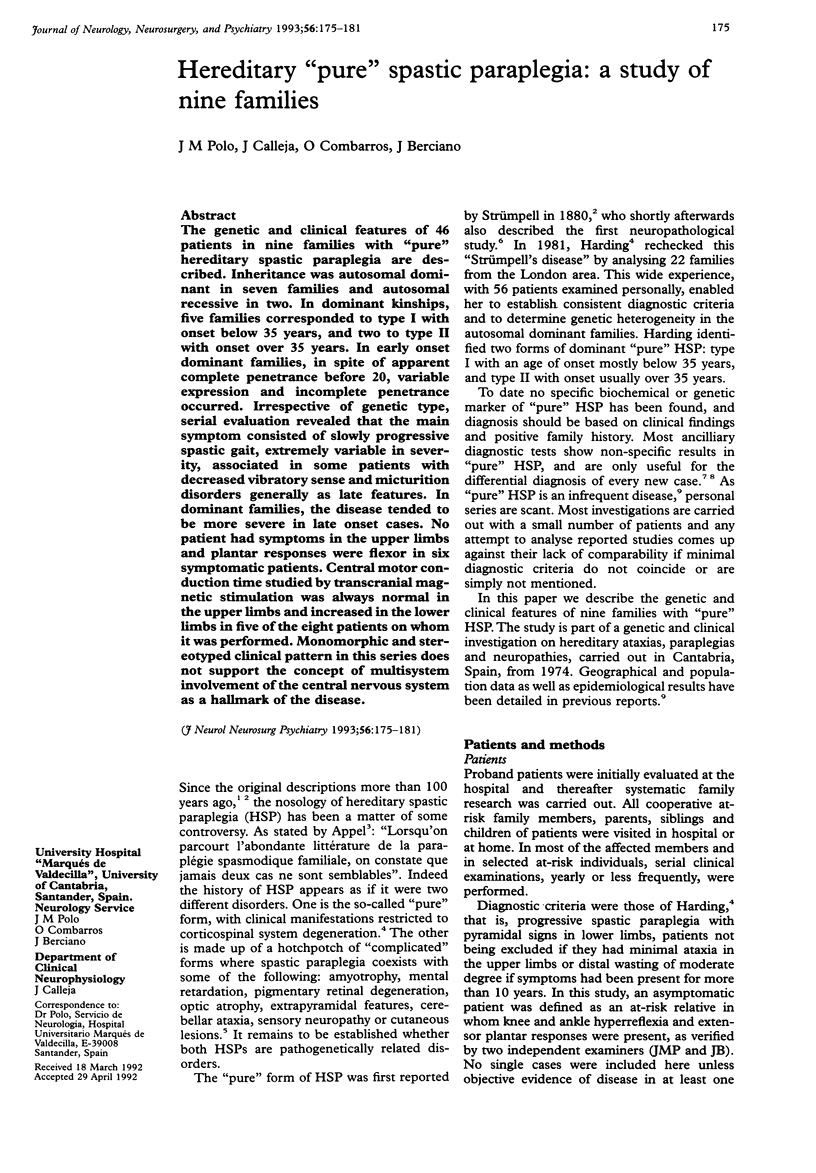
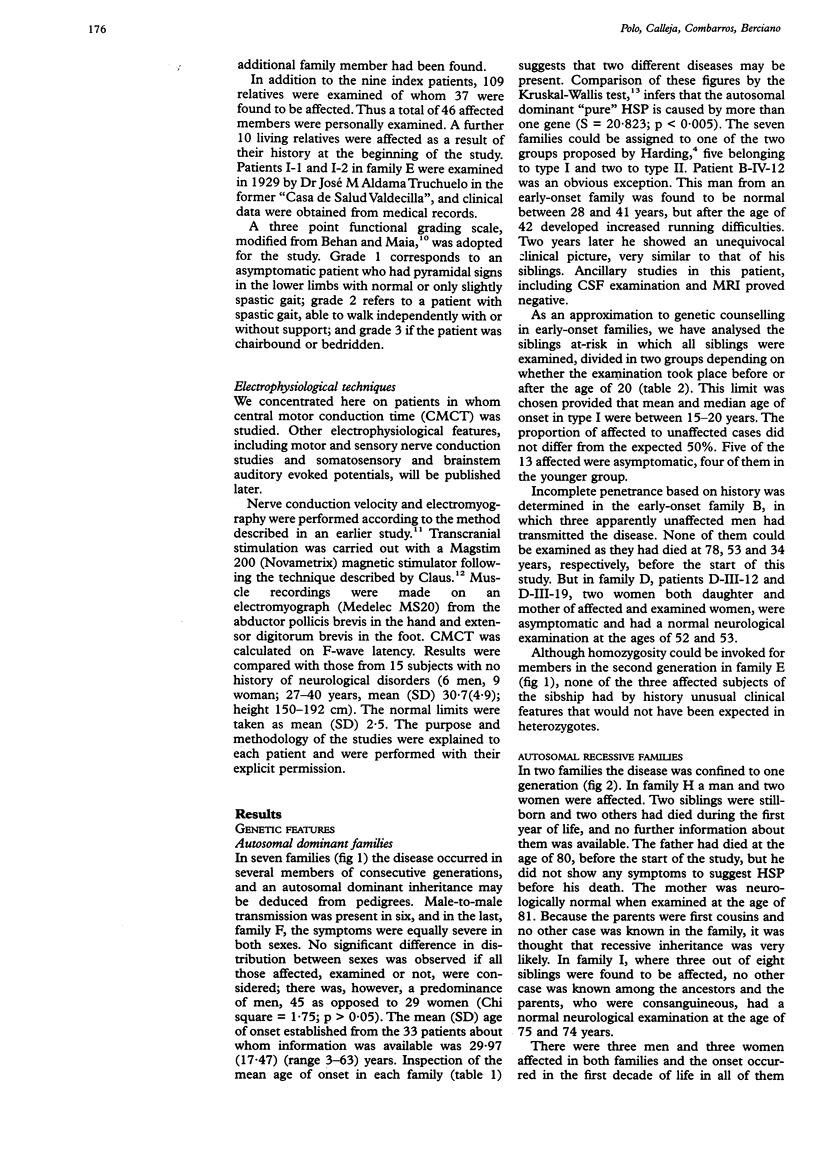

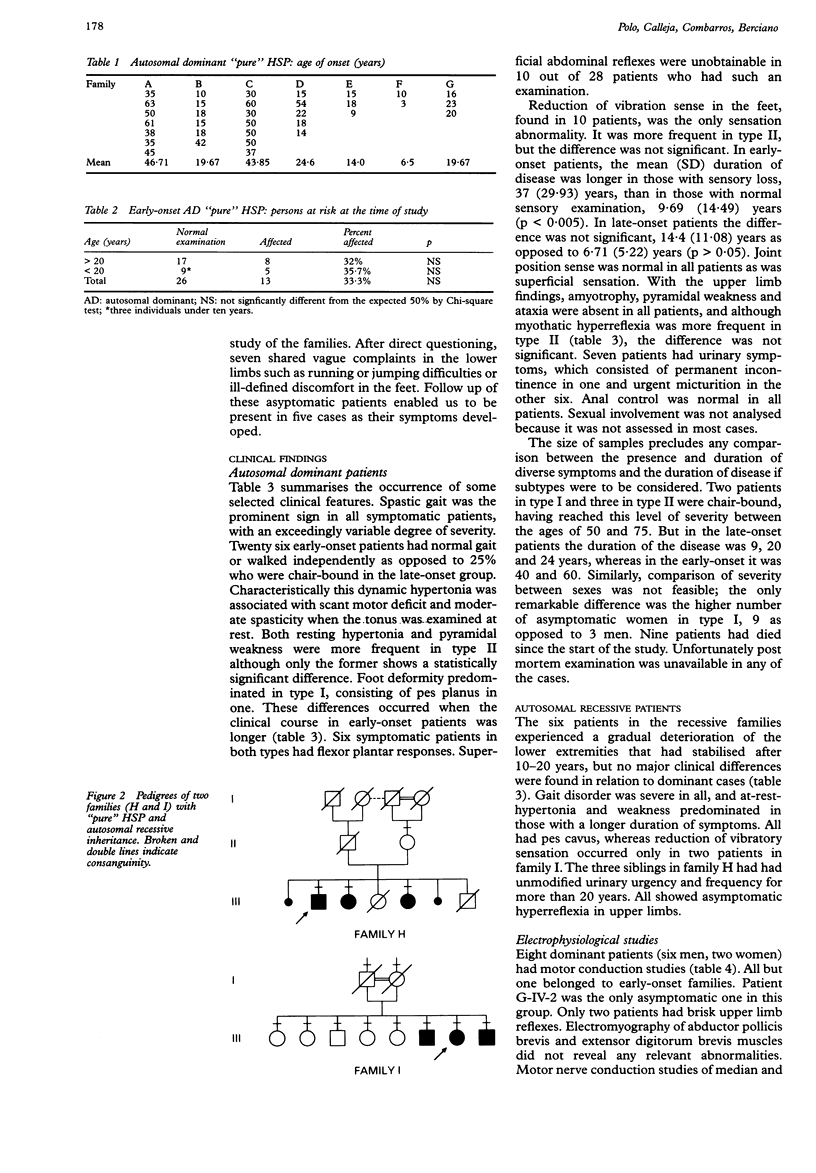

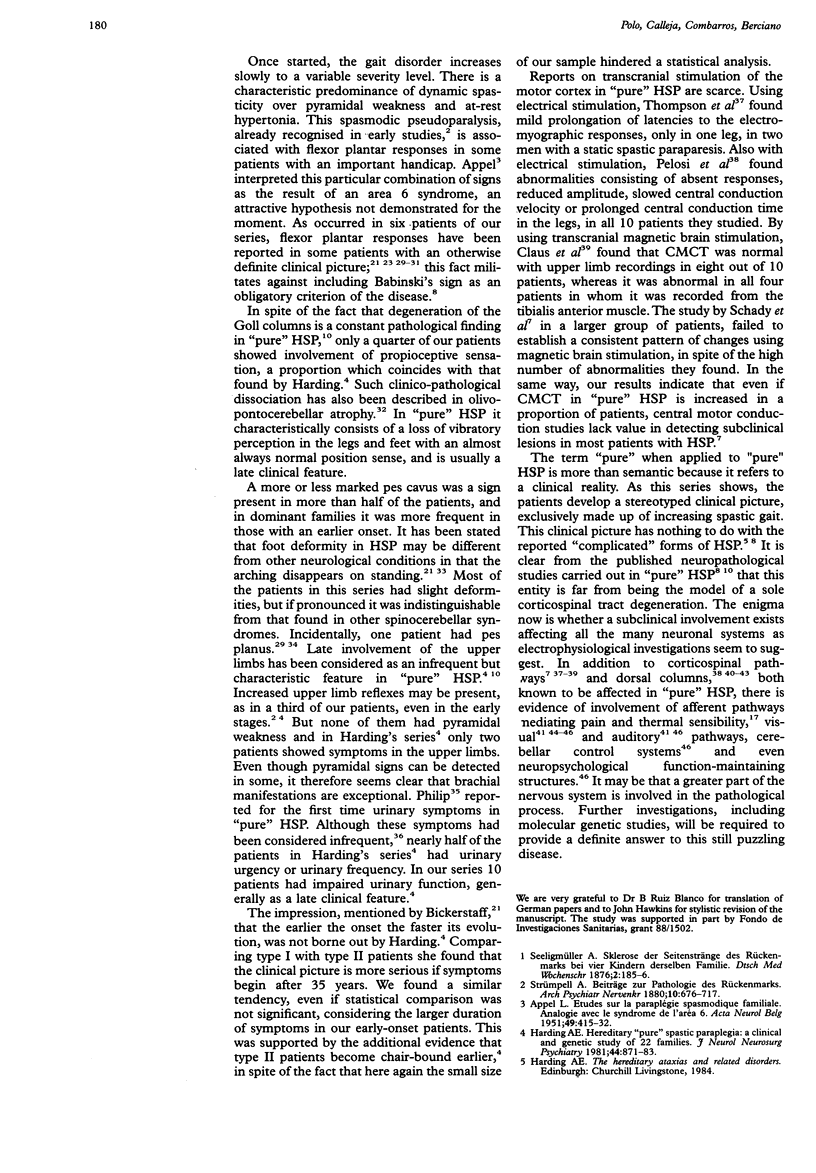
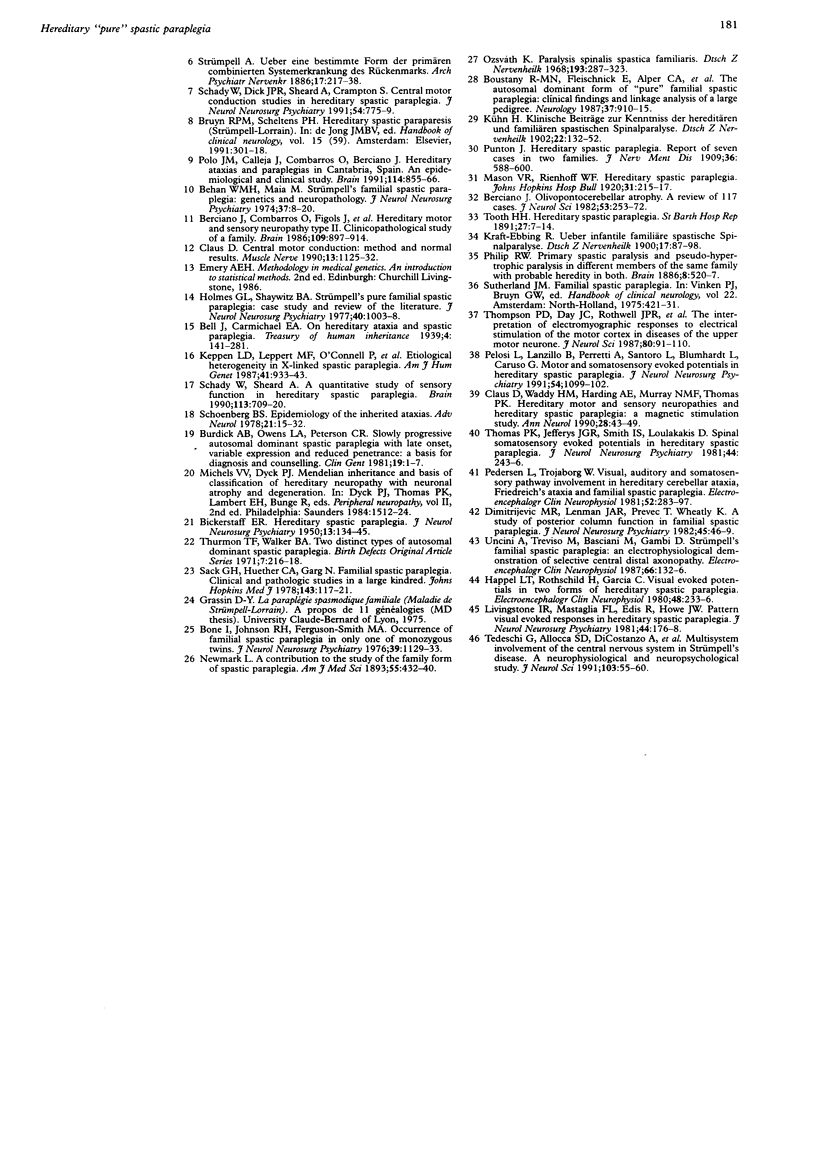
Selected References
These references are in PubMed. This may not be the complete list of references from this article.
- BICKERSTAFF E. R. Hereditary spastic paraplegia. J Neurol Neurosurg Psychiatry. 1950 May;13(2):134–145. doi: 10.1136/jnnp.13.2.134. [DOI] [PMC free article] [PubMed] [Google Scholar]
- Behan W. M., Maia M. Strümpell's familial spastic paraplegia: genetics and neuropathology. J Neurol Neurosurg Psychiatry. 1974 Jan;37(1):8–20. doi: 10.1136/jnnp.37.1.8. [DOI] [PMC free article] [PubMed] [Google Scholar]
- Berciano J., Combarros O., Figols J., Calleja J., Cabello A., Silos I., Coria F. Hereditary motor and sensory neuropathy type II. Clinicopathological study of a family. Brain. 1986 Oct;109(Pt 5):897–914. doi: 10.1093/brain/109.5.897. [DOI] [PubMed] [Google Scholar]
- Berciano J. Olivopontocerebellar atrophy. A review of 117 cases. J Neurol Sci. 1982 Feb;53(2):253–272. doi: 10.1016/0022-510x(82)90011-9. [DOI] [PubMed] [Google Scholar]
- Boustany R. M., Fleischnick E., Alper C. A., Marazita M. L., Spence M. A., Martin J. B., Kolodny E. H. The autosomal dominant form of "pure" familial spastic paraplegia: clinical findings and linkage analysis of a large pedigree. Neurology. 1987 Jun;37(6):910–915. doi: 10.1212/wnl.37.6.910. [DOI] [PubMed] [Google Scholar]
- Burdick A. B., Owens L. A., Peterson C. R. Slowly progressive autosomal dominant spastic paraplegia with late onset, variable expression and reduced penetrance: a basis for diagnosis and counseling. Clin Genet. 1981 Jan;19(1):1–7. doi: 10.1111/j.1399-0004.1981.tb00659.x. [DOI] [PubMed] [Google Scholar]
- Claus D. Central motor conduction: method and normal results. Muscle Nerve. 1990 Dec;13(12):1125–1132. doi: 10.1002/mus.880131207. [DOI] [PubMed] [Google Scholar]
- Claus D., Waddy H. M., Harding A. E., Murray N. M., Thomas P. K. Hereditary motor and sensory neuropathies and hereditary spastic paraplegia: a magnetic stimulation study. Ann Neurol. 1990 Jul;28(1):43–49. doi: 10.1002/ana.410280109. [DOI] [PubMed] [Google Scholar]
- Happel L. T., Rothschild H., Garcia C. Visual evoked potentials in two forms of hereditary spastic paraplegia. Electroencephalogr Clin Neurophysiol. 1980 Feb;48(2):233–236. doi: 10.1016/0013-4694(80)90309-0. [DOI] [PubMed] [Google Scholar]
- Harding A. E. Hereditary "pure" spastic paraplegia: a clinical and genetic study of 22 families. J Neurol Neurosurg Psychiatry. 1981 Oct;44(10):871–883. doi: 10.1136/jnnp.44.10.871. [DOI] [PMC free article] [PubMed] [Google Scholar]
- Holmes G. L., Shaywitz B. A. Strumpell's pure familial spastic paraplegia: case study and review of the literature. J Neurol Neurosurg Psychiatry. 1977 Oct;40(10):1003–1008. doi: 10.1136/jnnp.40.10.1003. [DOI] [PMC free article] [PubMed] [Google Scholar]
- Keppen L. D., Leppert M. F., O'Connell P., Nakamura Y., Stauffer D., Lathrop M., Lalouel J. M., White R. Etiological heterogeneity in X-linked spastic paraplegia. Am J Hum Genet. 1987 Nov;41(5):933–943. [PMC free article] [PubMed] [Google Scholar]
- Livingstone I. R., Mastaglia F. L., Edis R., Howe J. W. Pattern visual evoked responses in hereditary spastic paraplegia. J Neurol Neurosurg Psychiatry. 1981 Feb;44(2):176–178. doi: 10.1136/jnnp.44.2.176. [DOI] [PMC free article] [PubMed] [Google Scholar]
- O'Connell J. E. Craniopagus twins: surgical anatomy and embryology and their implications. J Neurol Neurosurg Psychiatry. 1976 Jan;39(1):1–22. doi: 10.1136/jnnp.39.1.1. [DOI] [PMC free article] [PubMed] [Google Scholar]
- Ozsváth K. Paralysis spinalis spastica familiaris. Dtsch Z Nervenheilkd. 1968 Jun 5;193(4):287–323. [PubMed] [Google Scholar]
- Pedersen L., Trojaborg W. Visual, auditory and somatosensory pathway involvement in hereditary cerebellar ataxia, Friedreich's ataxia and familial spastic paraplegia. Electroencephalogr Clin Neurophysiol. 1981 Oct;52(4):283–297. doi: 10.1016/0013-4694(81)90057-2. [DOI] [PubMed] [Google Scholar]
- Pelosi L., Lanzillo B., Perretti A., Santoro L., Blumhardt L., Caruso G. Motor and somatosensory evoked potentials in hereditary spastic paraplegia. J Neurol Neurosurg Psychiatry. 1991 Dec;54(12):1099–1102. doi: 10.1136/jnnp.54.12.1099. [DOI] [PMC free article] [PubMed] [Google Scholar]
- Polo J. M., Calleja J., Combarros O., Berciano J. Hereditary ataxias and paraplegias in Cantabria, Spain. An epidemiological and clinical study. Brain. 1991 Apr;114(Pt 2):855–866. doi: 10.1093/brain/114.2.855. [DOI] [PubMed] [Google Scholar]
- Sack G. H., Huether C. A., Garg N. Familial spastic paraplegia-clinical and pathologic studies in a large kindred. Johns Hopkins Med J. 1978 Oct;143(4):117–121. [PubMed] [Google Scholar]
- Schady W., Dick J. P., Sheard A., Crampton S. Central motor conduction studies in hereditary spastic paraplegia. J Neurol Neurosurg Psychiatry. 1991 Sep;54(9):775–779. doi: 10.1136/jnnp.54.9.775. [DOI] [PMC free article] [PubMed] [Google Scholar]
- Schady W., Sheard A. A quantitative study of sensory function in hereditary spastic paraplegia. Brain. 1990 Jun;113(Pt 3):709–720. doi: 10.1093/brain/113.3.709. [DOI] [PubMed] [Google Scholar]
- Schoenberg B. S. Epidemiology of the inherited ataxias. Adv Neurol. 1978;21:15–32. [PubMed] [Google Scholar]
- Thomas P. K., Jefferys J. G., Smith I. S., Loulakakis D. Spinal somatosensory evoked potentials in hereditary spastic paraplegia. J Neurol Neurosurg Psychiatry. 1981 Mar;44(3):243–246. doi: 10.1136/jnnp.44.3.243. [DOI] [PMC free article] [PubMed] [Google Scholar]
- Thurmon T. F., Walker B. A. Two distinct types of autosomal dominant spastic paraplegia. Birth Defects Orig Artic Ser. 1971 Feb;7(1):216–218. [PubMed] [Google Scholar]
- Uncini A., Treviso M., Basciani M., Gambi D. Strümpell's familial spastic paraplegia: an electrophysiological demonstration of selective central distal axonopathy. Electroencephalogr Clin Neurophysiol. 1987 Feb;66(2):132–136. doi: 10.1016/0013-4694(87)90182-9. [DOI] [PubMed] [Google Scholar]


